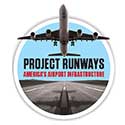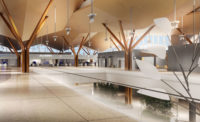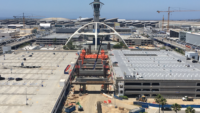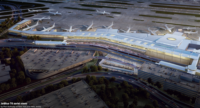Far out on an O’Hare International Airport airfield, Ginger Evans, Chicago’s aviation commissioner, faced a barrage of TV cameras, recording devices and reporters with notebooks. Behind her, a poster board displayed different potential configurations for a brand-new Terminal 2.
“This is a historic opportunity, and we have to be very careful about which configuration to select,” Evans explained, adding that there already had been 19 technical meetings with airline representatives.
Earlier, she had stood with other Chicago political powerhouses, including Mayor Rahm Emanuel (D) and Senator Dick Durban (D). Emanuel cited the importance of O’Hare to the city’s economic and global presence, saying, “New York, London, Berlin, Beijing—watch out! We’re coming for you.”
 At the July 15 press conference, Emanuel also announced that, in the near term, construction of nine new gates would start at Terminal 5 at a cost of $300 million, funded by passenger fees. Just a month before, Chicago’s department of aviation announced a $350-million investment in two new on-site hotels and the refurbishment of an existing one.
At the July 15 press conference, Emanuel also announced that, in the near term, construction of nine new gates would start at Terminal 5 at a cost of $300 million, funded by passenger fees. Just a month before, Chicago’s department of aviation announced a $350-million investment in two new on-site hotels and the refurbishment of an existing one.
Construction is underway on a $1.3- billion airfield improvement program, which includes a new $600-million center runway more than 11,000 ft long, demolishing an existing diagonal runway, relocating hangars and other facilities, and new taxiways. Demolishing an old runway, which is no longer up to federal safety standards, opens up 400 acres for expansion, Evans notes, adding, “It’s a blank-slate opportunity.”
In addition, a joint venture of Austin Commercial and Power Construction is the construction manager-at-risk (CMAR) for an $800-million consolidated rental-car facility and multimodal hub, which received a $290-million TIFIA loan. The initial cost estimates came in very over budget, but the CMAR team was able to value-engineer costs back down, thanks largely to precast construction, says Jonathan Leach, O’Hare’s chief operating officer. Parsons Corp. holds a $310-million design-build contract for a 2,000-ft aerial extension of the airport’s people mover into the hub.
Other projects include new cargo facilities and hangars, new water generators and chillers, deicing facilities and a fire station. “We have $2 billion in construction underway,” says Leach, who gave ENR an airfield tour that included a stop to see the first LEED-certified air traffic control tower.
On Tour: Midwest, Texas
Chicago was the final stop on the first leg of ENR’s “Project Runways: America’s Airport Infrastructure” tour. This leg focused on airport work in the Midwest and Texas.
Speaking at the briefing about the ultimate plan for a new terminal, American Airlines Chairman and CEO Doug Parker remarked, “That old antique ‘charm’ may work for Wrigley Field, but it’s not quite the same for an airport.”
Airport officials in Kansas City, Mo., could not agree more. Justin Meyer, deputy director of aviation for marketing and air service development at Kansas City International (KCI) Airport, walked through the corridor that more or less serves as the site for ticketing lobbies, a concourse with concessions, checkpoint entrances and baggage claim—all within its 72-ft width.
The three horseshoe-shaped terminals, which opened in 1971, are beloved by locals because their configuration makes the distance very short from any gate to the curbside. But in terms of security, functionality and growth potential, they have long been outdated. For example, due to a lack of space, American Airlines fliers don’t have the option of TSA Precheck. For Southwest Airlines passengers, Meyer says, “We built an exterior elevated hallway that looks like a gerbil tube to connect two departure lounges.”
Unlike most terminals, KCI doesn’t have gates on both sides of the concourse and only minimal space for concessions and restaurants. Sometimes a gate area is so crowded that people sit on the floor.
KCI officials have spent over a decade on a master-planning process, talking with locals about a new terminal, says Meyer. “We spent two years working with airline partners and coming up with an excellent financial deal. Unfortunately, the pause button has been pushed on that.”
Ironically, the airport has plenty of land and one empty terminal, due to airline mergers and the trend of fewer, fuller flights. But reopening that terminal to relieve congestion at the existing one would be like buying a second outdated car for a growing family, says Meyer.
“We identified a single-terminal solution years ago,” he says. Working with the airline tenants, the airport whittled down 40 concepts to two options for renovation and two options for a new terminal and concluded that a $1-billion new centralized terminal would be the best investment. They went to the City Council in April. “The airlines said they would back the debt service,” says Meyer.
But the “it’s good enough for us” mentality dominated that day, and KCI will have to wait until next year to try again.
Dallas Dreams
Khaled Naja’s office is located in a building that, a little over a year ago, consolidated 10 buildings’ worth of Dallas-Fort Worth (DFW) airport departments. Another way the airport is rebranding itself is the $2.3-billion Terminal Renewal Improvement Program (TRIP), a seven-year effort to remodel the airport’s four legacy terminals to improve the overall travel experience for DFW passengers. TRIP is enhancing concessions, expanding security checkpoints, reconfiguring ticket counters, installing a redundant fiber-optic and data communication network, and improving parking.
Launched in 2011, the program is more than 75% complete, says Naja, executive vice president of development and planning at DFW. The airport also launched a new slogan, “Travel Transformed,” with the goal of being a world-class airport for customer service, amenities and concessions.
TRIP differs from the airport’s previous $2.5-billion greenfield expansion program, which produced a new 2.1-million-sq-ft terminal and a new on-airport transit system. Unlike that program, “there is no stakeholder not involved,” says Rick Jones, assistant vice president for design, code and construction at DFW, who gave the tour for ENR. During TRIP, American Airlines merged with US Airways, requiring new set-ups, spaces and redesigns.
While that program relied on CMAR contracts, DFW recently has implemented nine indefinite-delivery, indefinite-quantity contracts (IDIQ). “It’s a trend that the Federal Aviation Administration is suggesting,” says Laddie Irion, national aviation segment leader for HNTB, which won a project management-construction management contract for non-federal work at DFW. AECOM won the federal contract.
Naja says the airport received more than 125 proposals for the IDIQ contracts and is committed to holding free contracting forums every six months to share its future construction plans nine months ahead of time. “We promised transparency,” Naja says. “We also want to attract smaller design firms who can’t bond for larger jobs.”
The airport also is increasing its function as an intermodal center. In addition to a recently completed rail station that links to Dallas’ rapid transit system, “we are preparing to build a rail station near Terminal B with $40 million in airport funds,” says Naja. The 27-mile commuter-rail link, called TEX, will connect the airport with downtown Fort Worth.
High Hopes in Houston
DFW is not alone in its fresh emphasis on world-class customer experiences. “Many of the airports in Europe are heavily international-focused, and the retail experiences are designed around that,” says Steve Anderson, executive program manager with Turner & Townsend, which holds an executive project management contract with the Houston Airport System. “In the U.S., there is a slow trend in improving that experience.”
Following that trend, United Airlines and the airport last year broke ground on a $244-million project to build a new 265,000-sq-ft concourse, more than 100,000 sq ft larger than the existing Terminal C North. That terminal will be demolished to enable reconstruction of the international terminal.
Hobby Airport also received a terminal renovation, a new parking garage and a new concourse for Southwest, says Jarrett Simmons, assistant director of aviation planning. “Part of that program [includes] new roads and utilities so that we have the capability to expand the concourse even farther,” he adds.
Simmons notes that, unlike many of its counterparts, the Houston airports have not exhausted their construction funding capacity via passenger facility charges, which were only recently raised to $4.50 per flight. “Otherwise, we’re much like other airports in that we’re between 50 to 70 years old,” he adds. “We’re also playing catch-up on our infrastructure.”
Houston’s third airport, Ellington Field, is even older—it turns 100 next year. But the joint-use military and general aviation facility will enter its second century with a transformative vision: a licensed spaceport that may some day accommodate aircraft that take tourists into space.
Phase one is under design for 90 acres’ worth of a campus development, which will include office buildings, drone manufacturing facilities, academic facilities, hotels and retail spaces, says Arturo Machuca, general manager at Ellington. “We envision building 250,000 sq ft, and we see $200 million in potential building value.”
“We’re much like other airports … we’re playing catch-up on our infrastructure.”
—Jarrett Simmons, Assistant director, aviation planning, Houston Airport System
Last year, the airport obtained its spaceport license, making it the 10th in the nation—and the first, says Machuca, to be located in a vibrant urban environment. “We’re located along the boulevard that connects to the Johnson Space Center,” he adds. “The location couldn’t have been better if we’d planned it.” Machuca has already negotiated deals with some companies and expects more to come.
“The move for airports to get licensed as spaceports is based on the assumption that, within the next 10 years, there will be several kinds of operational vehicles that can launch from them,” says Ken Ibold, senior aviation consultant with RS&H, which helped to develop the feasibility study for the license.
Although airports licensed as spaceports can initially just repurpose infrastructure, Ibold says that, at some point, spacecraft may connect cities. “Once it’s a common commercial enterprise, then you’ll have to start building dedicated infrastructure,” he notes.











Post a comment to this article
Report Abusive Comment